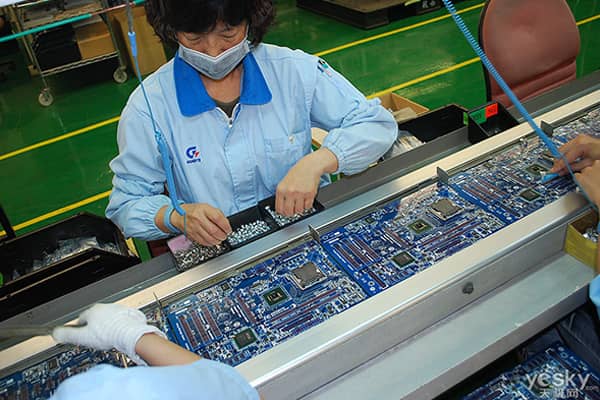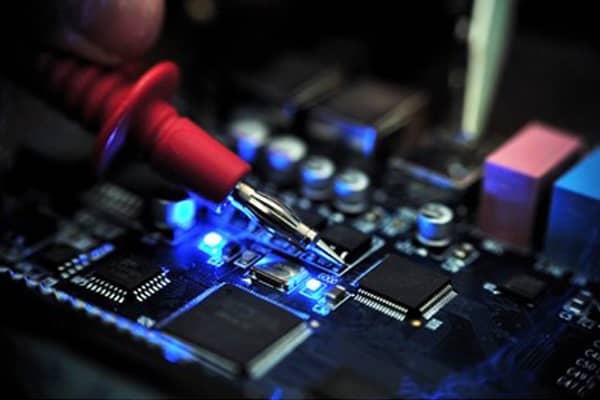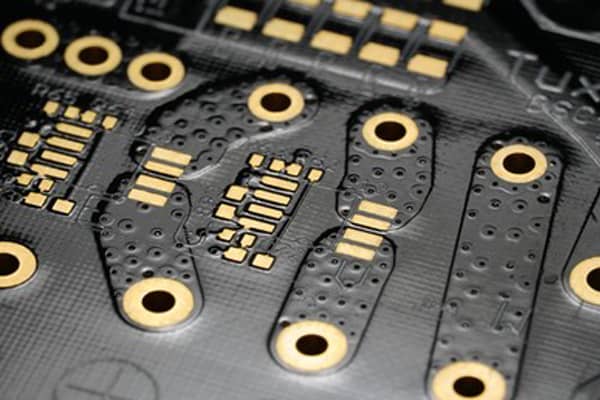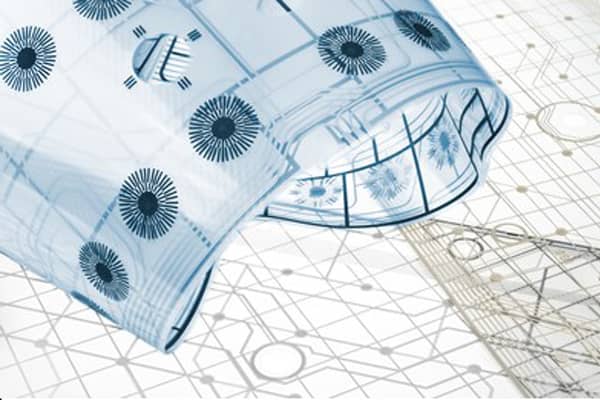Soldering is an essential process in PCBA manufacturing because it connects the components to the board. All PCBAs need to go through a process that can apply solder to the PCB; however, the process may differ as several soldering processes are available.
Wave soldering and reflow soldering are the commonly used soldering processes in the industry. Most of the time, new buyers and beginners get confused about what these processes mean. Understanding the difference between these soldering processes is important to know which one is suitable for your PCBA.
Let’s have an in-depth look at the difference between reflow soldering and wave soldering. But before that, it is better to have a look at the basics of these processes.

What are wave soldering and reflow soldering, and what is the difference between them?
What is Wave Soldering?
In wave soldering, an artificial wave is created using the wave soldering machine. It looks like the waves we see in a sea, but the wave is of dissolved tin, and we can also call it dissolved solder. A PCB containing the components passes over the wave, and solder is applied to it.
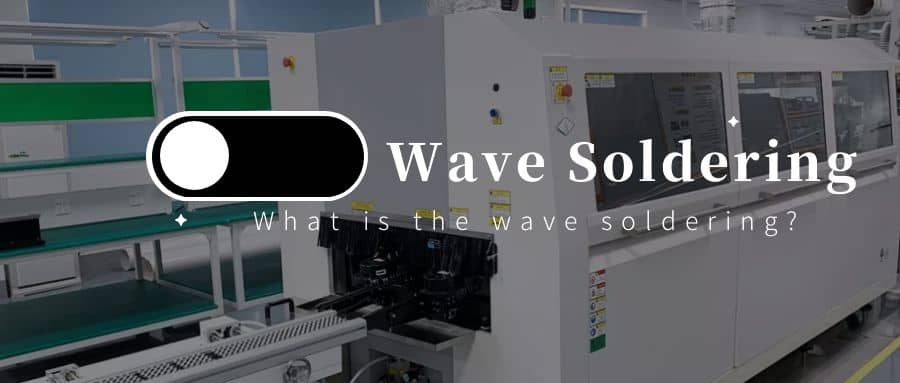
Wave Soldering Process

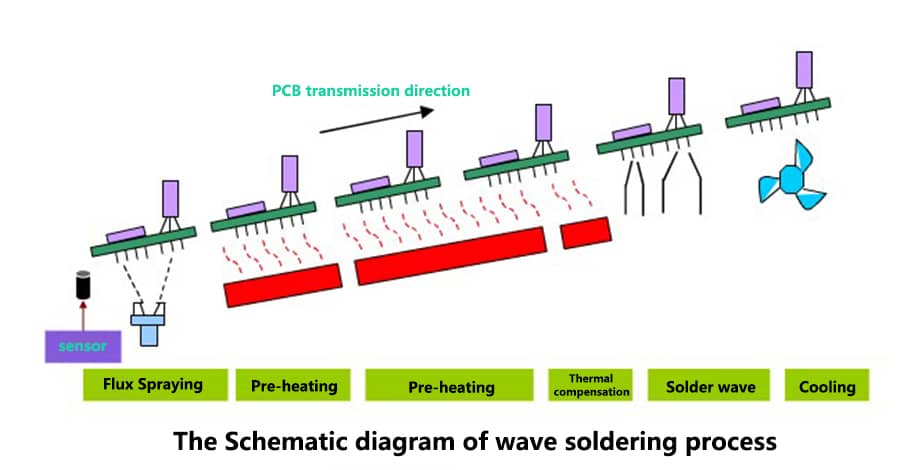
The process of wave soldering consists of four steps.
- Flux Spraying: In the first step, flux is sprayed because it is necessary before the application of solder. It cleans the PCB and offers various benefits. It removes the oxides from the surface and prevents the formation of oxides during the soldering process.
- Pre-heating: The next step is pre-heating. It heats the PCB so that the solder can be easily applied to the board.
- Wave Soldering: Now, the PCB goes over the wave of molten tin. The solder is applied over the PCB.
- Cooling: After the application of hot solder on the PCB, it is allowed to cool down.

Why choose wave soldering technology?
- Wave soldering is more suitable for PTH assembly;
- Wave soldering saves time and cost than manual soldering;
- Wave soldering shortens the contact time between the PCB and the high-temperature molten solder and reduces the warpage of the circuit board;
- Wave soldering can provide stronger solder joint quality;
- The molten solder isolates the air and reduces the oxidation time;
- The solder in the wave soldering furnace is recycled to make the solder composition more uniform.
What is Reflow Soldering?

Reflow Soldering Process
Reflow soldering is a bit different from wave soldering. In this method, a sticky solder paste is applied over the board using a solder stencil. The solder paste contains solder and flux, so both are applied at the same time. Then the components are placed using a pick and place machine. As the paste is sticky, it glues the components on the board so that they do not fall during the process.
After that, the boards pass through a reflow soldering oven with the help of a conveyor. The temperature inside the oven is more than the melting point of the solder, so it melts the solder, and the components are perfectly soldered to the board. Finally, the board is cooled to harden the solder.
Before reflow soldering, two more steps make the board ready for the soldering process. First, the board is preheated to increase its temperature so that the soldering process can be done easily. Then, the board goes through a thermal soak in which the flux inside the solder paste is activated. These two processes are involved in reflow soldering to facilitate the process.

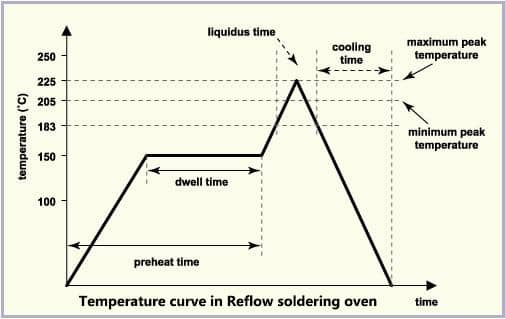
Advantages of reflow soldering
- The soldering quality of reflow soldering is good, and it is deeply trusted by consumers and PCBA manufacturers
- Reflow soldering is most suitable for SMT PCB assembly;
- Reflow soldering is most suitable for mass PCB assembly;
- Reflow soldering can assemble a variety of SMT package types
- The process flow of reflow soldering is easier to control and monitor
- Reflow soldering can limit the amount of solder and effectively avoid defects such as bridging;
- Reflow soldering can effectively reduce the damage of thermal shock to electronic components
Reflow Soldering vs Wave Soldering
- Complexity
Wave soldering is much more complex. At first, the board is placed on the conveyor belt, and it goes to the solder wave. It isn’t easy to achieve the solder wave and adjust its conditions. The wave might not offer the results if not handled carefully. The worker or handler must be an expert.
On the other hand, reflow soldering is much easier. The process is quite simple.
- Environmental Conditions
Environmental conditions are necessary to maintain because the solder is in molten condition to form a wave. Any fluctuation will affect the wave, which will directly impact the quality of solder joints.
In reflow soldering, it is difficult to maintain all the conditions. The wave of the solder needs to be under perfect environmental conditions to work as expected.
First, the board is preheated to increase its temperature. This preheating needs to be done carefully under controlled conditions. Otherwise, it can destroy the board. Then, the molten solder needs to be at the required temperature to behave like a fluid. Due to temperature shifts, there can be defects and imperfections in the soldering. Thus, the environmental conditions need to stay stable.
In reflow soldering, the conditions can be controlled easily. The reflow oven only needs to melt the solder in the paste. It is much easier because the conditions can be easily maintained.
- Constraints
Other than temperature, there are more constraints. In reflow soldering, the duration of the board under the wave has an impact on the soldering quality. It needs to be done very precisely, and the time cannot exceed the limits. If the board stays longer, then there will be excess solder, and if the board stays lesser than usual, the pads and joints won’t be perfect, or some components might not have enough solder. Thus, it is essential to control the duration of the board under the wave.
Moreover, the pad shape, size, orientation, and many other things play an important role in wave soldering.
In reflow soldering, you need to control the time, but it is easier.
- Speed
Wave soldering is much quicker than reflow soldering. Therefore, it is preferred for large volume PCB productions. It is because the flux is sprayed, and the PCBs just go over the solder wave. But in reflow soldering, solder paste is applied using a stencil, and then the PCB spends time inside the reflow oven.
- Cost
Wave soldering is a cheaper option compared to reflow soldering. For large volume orders, wave soldering is the most suitable option.
Reflow soldering is expensive as you need a special stencil production, and the reflow oven is more expensive than a wave soldering machine.
- Usage
Wave soldering is perfect for through-hole components, and reflow soldering is perfect for SMDs.
Which One Should I Choose, Wave Soldering or Reflow Soldering?
The type of soldering method you need depends on various factors, such as the components, size, and volume. Boards usually have a mixture of through-hole and SMT components. So, you cannot rely on one soldering technique. There can be multiple stages to use both soldering methods.
You need to discuss it with your PCB manufacturer. It is decided on various factors, so the right advice can be given by the expert who is manufacturing your PCBA. You cannot decide it on your own. PCB manufacturers have a complete idea as they do this every day.
JHYPCB: One-stop Solution for Your PCBs and PCBAs
JHYPCB is a well-known PCB and PCBA service provider. We can handle large to small volume orders without any restriction on the minimum order quantity. Our experts can handle your complex projects and guide you well in achieving the results you need. Whether you need PCB prototypes, full turnkey assembly services, stencils, or anything else, we are ready for you.
Our state-of-the-art facility can deal with all types of PCBs and PCBAs. We have the latest technology to offer optimal and quick results. We are RoHS, UL, and ISO certified. We can deliver your PCBs and PCBAs at the fastest delivery time and lowest cost. For more information and details, feel free to contact our customer support team.



